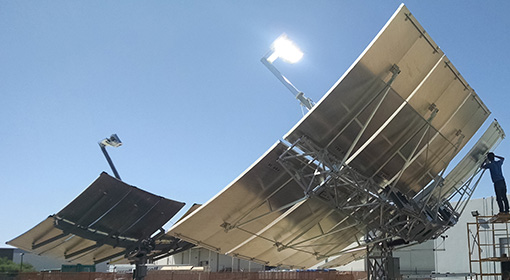The SST Solar Dish collector is sized for distributed scale industrial or utility applications. Each dish is approx. 55 square meters of mirror collector area. Multiple dishes can be grouped into systems of any size, and arranged to conform to available land area with minimal grading. Common field equipment is used for installation and service.
This is in contrast to the very large CSP type troughs and towers collectors designed for utility steam power generation, which typically require very large system sizes and complete grading of land. Solar Dish systems can be installed in locations not practical for troughs and towers.
Solar Dish systems use two-axis tracking to point directly to the sun at all times. This provides maximum output throughout the year, for higher annual output than solar troughs and heliostat systems. Solar trough and heliostat systems have a particularly steep drop in output in the winter when the sun is low, and 40% or more of available sunlight is lost. Solar dish systems can also be used at high latitudes, where troughs and towers are much less effective.
BENEFITS & FEATURES
- Higher output for year round operation, especially in upper latitudes where the sun is lower in the sky, compared to trough or tower systems. Annual energy is nearly 2,500 hours per year in Arizona sun conditions.
- Any size of system can be built with multiple dishes, phased installations. Higher temperatures possible compared to trough, limited primarily by the thermal fluid used.
SST SOLAR DISH TYPES
Concentrating Photovoltaic (CPV) Dish
- CPV Receiver design rating is 15 kW electric, using 12 CPV modules
- 250VDC output to connect to inverter. Optional DC voltages: 50V to 400V
- CPV modules use water/glycol liquid cooling. Heat is either rejected to air using a radiator, or this cooling loop can be used to provide byproduct heat for local use up to 60C (140F), up to 25 kW
Thermal Dish
- Thermal Receiver design rating is 40 kW thermal, using two heat receiver coils
- Output temperature to be determined by customer application, and choice of thermal fluid. Water can be used typically up to 180C. Higher temperatures can be achieved (up to 350 C) using thermal oil.


